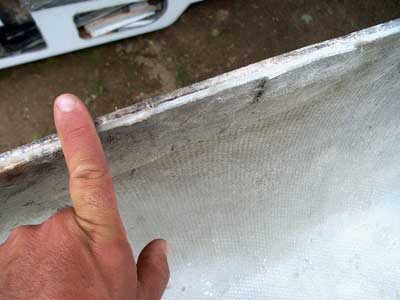
|
|
~MENU~ |
| Home |
| The Concept |
| The Boat |
| Bringing Her Home |
|
Weekly Progress Log |
|
Daysailor Projects |
| The Boat Barn |
| Resources |
| Other Sites |
| Email Tim |
|
|
| Unbuilding: Deck Removal (Page 3) | |||
|
In a short period of time, it's amazing the sort of irreversible destruction one can wield with a power saw. |
Interior Demolition | ||
| Engine Removal | |||
| Parts Removal | |||
| Projects Menu | Deck Removal | ||
| Sunday, June 8, 2003
A few days after cutting off the bulk of the deck, I found some time to finish the job. We had left much of the molded toerail in place, along with some sections of the deck near the stem and around the chainplates. Now it was time to remove the rest of this material. Using both my reciprocating saw and jig saw, I removed the rest of the fiberglass toerail, cutting more or less along the natural seam between hull and deck. I erred on the side of staying above the line, as I can always grind it down to the exact height later. (Any unevenness of the cut seen in photos of the job can be attributed to this.) In an hour or less, I had the entire port toerail, and the remains of the starboard one, cut down, and the last section of foredeck removed. I also cut down the remaining forward bulkhead (the mast area) to remove the ragged pieces of tabbed-on decking that remained, though most of the bulkhead remained in place.
The photos below show the hull after removing toerails and other remaining bits, and were taken after the boat had been moved to her new location in my yard. |
 I
discovered that the upper part of the hull was surprisingly thin.
Discounting the thickness of the tabbing that had been used to secure the
deck and hull together, the upper portion of the hull shell at the gunwale
was only about 1/4" or so. The thickness in the bottom, where
visible around old through hull installations, is about 3/4".
These thicknesses are substantially less than what I have found on #381
I
discovered that the upper part of the hull was surprisingly thin.
Discounting the thickness of the tabbing that had been used to secure the
deck and hull together, the upper portion of the hull shell at the gunwale
was only about 1/4" or so. The thickness in the bottom, where
visible around old through hull installations, is about 3/4".
These thicknesses are substantially less than what I have found on #381 


